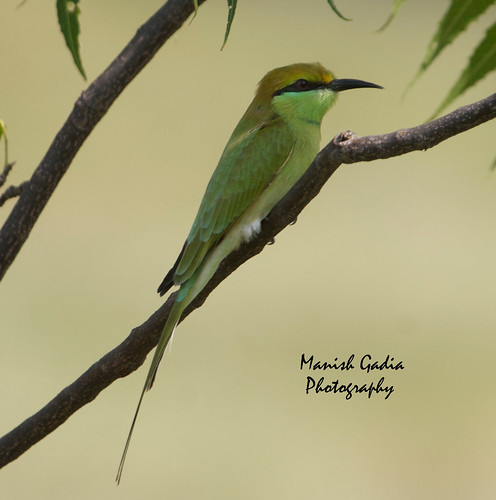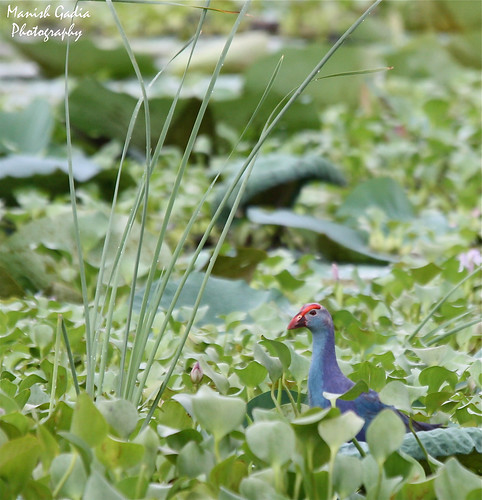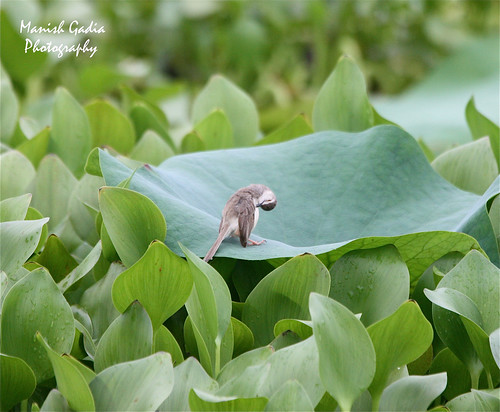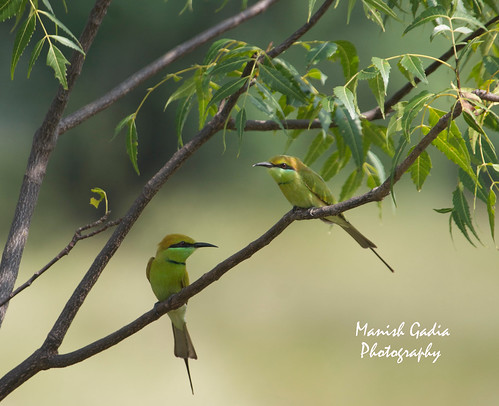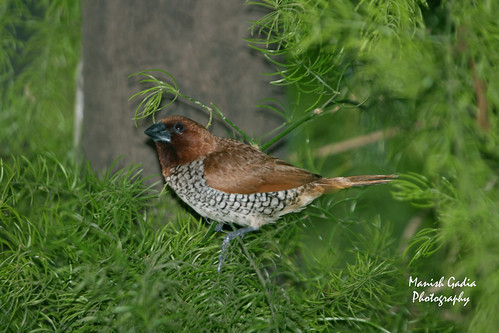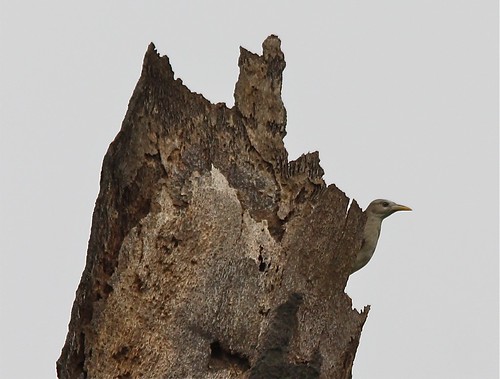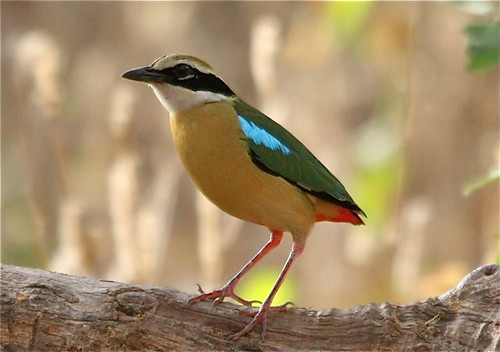1) Gulmohar / Delonix regia is a species of flowering plant from the Fabaceae family, noted for its fern-like leaves and flamboyant display of flowers. Often grown as an ornamental tree and given the name Royal Poinciana or Flamboyant, it is also known as Gulmohar (Hindi and Urdu), KrishnachuRa (Bengali), Malinche, and Tabachine, and one of several named the Flame tree. The species was previously placed in a genus Poinciana, named for Phillippe de Longvilliers de Poincy who is credited with introducing the plant to the Americas. The tree's vivid red/vermilion/orange/yellow flowers and bright green foliage make it an exceptionally striking sight.
The Royal Poinciana is endemic to Madagascar, where it is found in the Madagascar dry deciduous forests. In the wild it is endangered, but it is widely cultivated elsewhere. In addition to its ornamental value, it is also a useful shade tree in tropical conditions, because it usually grows to a modest height but spreads widely, and its dense foliage provides full shade. In areas with a marked dry season, it sheds its leaves during the drought, but in other areas it is virtually evergreen.

2) Rain Tree / Albizia saman is a species of flowering tree in the pea family, Fabaceae, that is native to the Neotropics. Its range extends from Mexico south to Peru and Brazil, but it has been widely introduced to South and Southeast Asia, as well as the Pacific Islands, including Hawaii. Common names include Saman, Rain Tree and Monkey Pod (see also below). It is often placed in the genus Samanea,[1] which by yet other authors is subsumed in Albizia entirely.
Saman is a wide-canopied tree with a large symmetrical crown. It usually reaches a height of 25 m (82 ft) and a diameter of 40 m (130 ft). The leaves fold in rainy weather and in the evening, hence the name Rain Tree and 5 o'clock Tree (Pukul Lima) in Malay. Several lineages of this tree are available e.g. with reddish pink and creamish golden colored flowers.

3) SAPTAPARNI / Alstonia scholaris (Apocynaceae, commonly called Blackboard tree, Indian devil tree, Ditabark, Milkwood pine, White cheesewood and Pulai; syn. Echites scholaris L. Mant., Pala scholaris L. Roberty) is an evergreen, tropical tree native to the Indian subcontinent and Southeast Asia. Alstonia scholaris is a small tree that grows up to 40 m tall and is glabrous. The bark is greyish; branchlets are copiously lenticellate.
The upperside of the leaves are glossy, while the underside is greyish. Leaves occur in whorls of 3-10; petioles are 1-3 cm; the leathery leaves are narrowly obovate to very narrowly spathulate, base cuneate, apex usually rounded; lateral veins occur in 25-50 pairs, at 80-90° to midvein. Cymes are dense and pubescent; peduncle is 4-7 cm long. Pedicels are usually as long as or shorter than calyx. The corolla is white and tube-like, 6-10 mm; lobes are broadly ovate or broadly obovate, 2-4.5 mm, overlapping to the left. The ovaries are distinct and pubescent. The follicles are distinct and linear.

4) Haldina cordifolia, syn. Adina cordifolia, also known as Kadam or Kadamba in Hindi, is a flowering plant in the family Rubiaceae, the sole species in the genus Haldina. It is native to southern Asia, from India east to southern China and Vietnam.
It is a deciduous tree that can grow well over 20 metres high. many people think the flowers are insignificant individually but are very pretty when they bloom together in balls with a circumference of 2 to 3 cm. They are usually yellow in colour often tinged with a shade of pink. Kadam is at its blossoming best during winter. The bark of the tree acts as an antiseptic.

5) Parijat / Nyctanthes arbor-tristis (Night-flowering Jasmine) is a species of Nyctanthes, native to southern Asia, from northern Pakistan and Nepal south through northern India and southeast to Thailand.
It is a shrub or a small tree growing to 10 m tall, with flaky grey bark. The leaves are opposite, simple, 6–12 cm long and 2–6.5 cm broad, with an entire margin. The flowers are fragrant, with a five- to eight-lobed white corolla with an orange-red centre; they are produced in clusters of two to seven together, with individual flowers opening at dusk and finishing at dawn. The fruit is a flat brown heart-shaped to round capsule 2 cm diameter, with two sections each containing a single seed.
The natives of Chhattisgarh are aware of medicinal uses of all parts of Parijat. They use the seeds in treatment of Bavasir (Piles). Daily one seed with water is recommended as treatment. This treatment is continued up to complete cure. The seeds are crushed and aqueous paste is prepared. The patients suffering from piles are advised by the natives to apply fresh paste externally on piles, along with the internal use of seeds. This treatment is simple and very effective. In treatment of gout, the natives use the decoction of Parijat flowers. This decoction is given up to one week during the time of attack. As treatment, it is given up to one month in a year. The natives of Sarguja region use the leaves of Parijat in many ways. In treatment of dry cough, the leaf juice with Shahad (Honey) is given internally. The aqueous paste of leaves is used externally in treatment of skin related troubles specifically in treatment of ring worm. The natives of Bastar region, prepare a special herbal oil by boiling fresh leaves in Sarson (Mustard) oil and use it externally in treatment of same troubles.
Parijat appears in several Hindu myths. In one myth, which appears in Bhagavata Purana, the Mahabharata and the Vishnu Purana, Parijat appeared as the result of the Samudra manthan (Churning of the Milky Ocean). In another myth, Parijat was brought to earth by Krishna from Indra's garden.
In Hindu mythology, there is a story involving Lord Krishna about a parijat and Krishna's two wives, Satyabhama and Rukmini. Satyabhama wanted this "Parijat" tree from the Heaven to be planted in her garden. Rukmini too, took a fancy to the flower. Krishna, wanting to keep both his wives happy, planted this tree so that the flowers fell in Rukmini’s garden while the tree remained in Satyabhama’s garden.[citation needed]
The tree was planted in the garden of Indra, the Lord of Heavens. Even as Krishna stole a branch of the tree he was spotted by Indra. However, Indra desisted from placing a curse on Krishna since he was an incarnation of Vishnu. Still, Indra put forth a curse on the stolen branch that it will never bear fruit even though the flowers may bloom on the tree. Since the day the tree was planted at Barabanki (the wives' garden), it flowers but does not reproduce, because it has no seeds and the branch cannot take root.

6) Couroupita guianensis / Kailashpati, whose common names include Ayahuma and the Cannonball Tree, is an evergreen tree allied to the Brazil Nut (Bertholletia excelsa), and is native to tropical northern South America and to the southern Caribbean. In India it is growing for the past two or three thousand years at least, as attested by textual records, hence it is possible that it was native to India also. It's part of the family Lecythidaceae and grows up to 25m in height. The Cannonball Tree is so-called because of its brown cannon ball-like fruits. The majority of these trees outside their natural environment have been planted as a botanical curiosity, as they grow very large, distinctive flowers. Its flowers are orange, scarlet and pink in color, and form large bunches measuring up to 3 m in length. They produce large spherical and woody fruits ranging from 15 to 24 cm in diameter, containing up to 200 or 300 seeds apiece.

7) Desi badam / Terminalia catappa is a large tropical tree in the Leadwood tree family, Combretaceae. The tree has been spread widely by humans and the native range is uncertain. It has long been naturalised in a broad belt extending from Africa to Northern Australia and New Guinea through Southeast Asia and Micronesia into the Indian Subcontinent. More recently the plant has been introduced to parts of the Americas. Common names include , Bengal almond, Singapore almond , Ebelebo, Malabar almond, Indian almond, Tropical almond, Sea almond, Beach Almond, Talisay tree, Umbrella tree, Abrofo Nkatie (Akan) and Zanmande (creole).
It grows to 35 metres (115 ft) tall, with an upright, symmetrical crown and horizontal branches. The Terminalia catappa has corky, light fruit that is dispersed by water. The nut within the fruit is edible when fully ripe,tasting almost like almond. As the tree gets older, its crown becomes more flattened to form a spreading, vase shape. Its branches are distinctively arranged in tiers.

8) Putranjiva is a plant genus of the family Putranjivaceae. Along with Drypetes (of the same family), it contains mustard oils as a chemical defense against herbivores. The ability to produce glucosinolates is believed to have evolved only twice, in the Putranjivaceae and the Brassicales.
The rosid family Putranjivaceae is composed of about 210 species of evergreen tropical trees distributed into 4 genera. Members of this family have 2-ranked coriaceous leaves, which, if fresh, typically have a radish-like or peppery taste. The flowers are fasciculate and usually small, and the fruits of these species are a single-seeded drupe crown by the persistent stigmas. This family has its origin in Africa and Malesia.

9) Bahava / The Golden Shower Tree (Cassia fistula see below for other names) is a flowering plant in the family Fabaceae, native to southern Asia, from southern Pakistan east through India to Myanmar and south to Sri Lanka. It is the national tree of Thailand.
Cassia fistula is widely grown as an ornamental plant in tropical and subtropical areas. It blooms in late spring. Flowering is profuse, with trees being covered with yellow flora, with almost no leaf being seen. It does not grow well in dry climates. Growth for this tree is best in full sun on well-drained soil; it is drought- and salt- tolerant, but will be damaged by even short spells of freezing weather. It can be subject to mildew, leaf spot and root diseases.
In Ayurvedic medicine, Golden Shower Tree is known as aragvadha ("disease killer"). Its fruitpulp is used as mild laxative, against fevers, arthritis, vatavyadhi (nervous system diseases), all kinds of rakta-pitta (bleeding, such as hematemesis or hemorrhages), as well as cardiac conditions and stomach problems such as acid reflux. The root is considered a very strong purgative, and self-medication or any use without medical supervision is strongly advised against in Ayurvedic texts.

10) Manilkara zapota, commonly known as the Sapodilla, is a long-lived, evergreen tree native to southern Mexico, Central America and the Caribbean.[1] It is grown in huge quantities in India, Pakistan, Mexico and was introduced to the Philippines during Spanish colonisation. The fruit has an exceptionally sweet malty flavor. Many believe the flavor bears a striking resemblance to caramel. The unripe fruit is hard to the touch and contains high amounts of saponin, which has astringent properties similar to tannin, drying out the mouth.
The trees can only survive in warm, typically tropical environments, dying easily if the temperature drops below freezing. From germination, the sapodilla tree will usually take anywhere from 5–8 years to bear fruit. The sapodilla trees yield fruit twice a year, though flowering may continue year round.

11) The Ashoka tree (lit., "sorrow-less") (S. asoca (Roxb.) Wilde, or Saraca indica L. ) is a plant belonging to the Caesalpiniaceae subfamily of the legume family.[1] It is an important tree in the cultural traditions of the Indian Subcontinent and adjacent areas.
The Ashoka is a rain-forest tree. Its original distribution was in the central areas of the Deccan plateau, as well as the middle section of the Western Ghats in the western coastal zone of the Indian Subcontinent. The Ashoka is prized for its beautiful foliage and fragrant flowers. It is a very handsome, small, erect evergreen tree, with deep green leaves growing in dense clusters.
Its flowering season is around February to April. The Ashoka flowers come in heavy, lush bunches. They are bright orange-yellow in color, turning red before wilting.
As a wild tree, the Ashoka is a vulnerable species. It is becoming rarer in its natural habitat, but isolated wild Ashoka trees are still to be found in the foothills of central and eastern Himalayas, in scattered locations of the northern plains of India as well as on the west coast of the Subcontinent near Mumbai.
There are a few varieties of the Ashoka tree. One variety is larger and highly spreading. The columnar varieties are common in cultivation. It is also used for medical purposes. The asoka tree is considered sacred throughout the Indian subcontinent, especially in India and Sri Lanka. This tree has many folklorical, religious and literary associations in the region. Highly valued as well for its handsome appearance and the color and abundance of its flowers, the asoka tree is often found in royal palace compounds and gardens as well as close to temples throughout India.
The asoka tree is closely associated with the Yakshi mythological beings. One of the recurring elements in Indian art, often found at gates of Buddhist and Hindu temples, is the sculpture of a Yakshi with her foot on the trunk and her hands holding the branch of a flowering ashoka tree. As an artistic element, often the tree and the Yakshi are subject to heavy stylization. Some authors hold that the young girl at the foot of this tree is based on an ancient fertility symbol.
The asoka tree has a symbolic importance in Buddhism. Queen Māyā of Sakya is said to have given birth to the Buddha under an asoka tree in a garden in Lumbini. According to tradition, the queen walked in the garden until she came to an ashoka tree to take a rest. Then the tree magically bent down for her and she grasped a branch. At that moment the Buddha emerged from her right side.
 Following is a good 8-9 Km Trek (60 minutes). Please note since there are steep climbs involved it can be strenuous.
Following is a good 8-9 Km Trek (60 minutes). Please note since there are steep climbs involved it can be strenuous. 